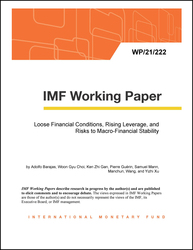
Loose Financial Conditions, Rising Leverage, and Risks to Macro-Financial Stability
Loose Financial Conditions, Rising Leverage, and Risks to Macro-Financial Stability
READ MORE...
Volume/Issue:
Volume 2021
Issue 222
Publication date: August 2021
ISBN: 9781513591483
$5.00
Add to Cart by clicking price of the language and format you'd like to purchase
Available Languages and Formats
| English |
Prices in red indicate formats that are not yet available but are forthcoming.
Topics covered in this book
This title contains information about the following subjects.
Click on a subject if you would like to see other titles with the same subjects.
Banks and Banking , Finance , Economics- Macroeconomics , Money and Monetary Policy , Economics / General , leverage buildup , A , Macroprudential policy , loose financial conditions , Policy implication , B , Macroprudential policy , Credit booms , Macroprudential policy , Central bank policy rate , Macroprudential policy instruments , Financial sector stability , Global
Summary
After a steady increase following the global financial crisis, private nonfinancial sector leverage rose further during the COVID-19 on the back of easy financial conditions induced by unprecedented policy support. We investigate the empirical relationships between increased leverage, financial conditions, and macro-financial stability in a sample of major advanced and emerging market economies. We find that loose financial conditions contribute to leverage buildups and generate an intertemporal tradeoff: financial stability risk is lessened in the near term but exacerbated in the medium term. The tradeoff is amplified during credit booms, when debt service burdens are particularly high, or when the share of foreign currency debt is high in emerging markets. Selected macroprudential tools can arrest leverage buildups and mitigate the tradeoff.
Copyright © 2010 - 2025
Powered by:
AIDC



